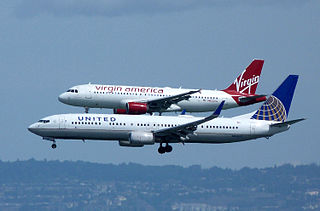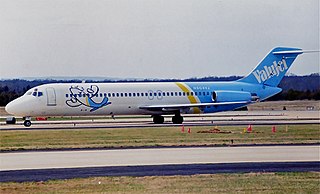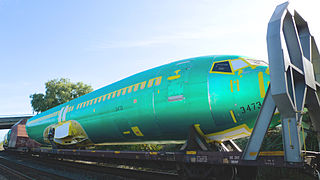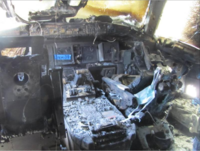
An airliner is a type of aircraft for transporting passengers and air cargo. Such aircraft are most often operated by airlines. Although the definition of an airliner can vary from country to country, an airliner is typically defined as an airplane intended for carrying multiple passengers or cargo in commercial service. The largest of them are wide-body jets which are also called twin-aisle because they generally have two separate aisles running from the front to the back of the passenger cabin. These are usually used for long-haul flights between airline hubs and major cities. A smaller, more common class of airliners is the narrow-body or single-aisle. These are generally used for short to medium-distance flights with fewer passengers than their wide-body counterparts.

ValuJet Airlines Flight 592 was a regularly scheduled flight from Miami to Atlanta. On May 11, 1996, the ValuJet Airlines McDonnell Douglas DC-9 operating the route crashed into the Everglades about 10 minutes after departing Miami as a result of a fire in the cargo compartment possibly caused by mislabeled and improperly stored hazardous cargo. All 110 people on board were killed. The airline already had a poor safety record before the crash, and the accident brought widespread attention to the airline's problems. ValuJet's fleet was grounded for several months after the accident. When operations resumed, the airline was unable to attract as many customers as it had before the accident. It acquired AirTran Airways in 1997, but the lingering damage to the ValuJet name led its executives to assume the AirTran name. It is also the deadliest plane crash in Florida as of now.

Saudia Flight 163 was a scheduled Saudia passenger flight departing from Quaid-E-Azam Airport in Karachi, Pakistan, bound for Kandara Airport in Jeddah, Saudi Arabia, via Riyadh International Airport in Riyadh, Saudi Arabia, which caught fire after takeoff from Riyadh International Airport on 19 August 1980. Although the Lockheed L-1011-200 TriStar made a successful emergency landing at Riyadh, the flight crew failed to perform an emergency evacuation of the airplane, leading to the deaths of all 287 passengers and 14 crew on board the aircraft from smoke inhalation.
An uncontrolled decompression is an undesired drop in the pressure of a sealed system, such as a pressurised aircraft cabin or hyperbaric chamber, that typically results from human error, structural failure, or impact, causing the pressurised vessel to vent into its surroundings or fail to pressurize at all.

An oxygen mask is a mask that provides a method to transfer breathing oxygen gas from a storage tank to the lungs. Oxygen masks may cover only the nose and mouth or the entire face. They may be made of plastic, silicone, or rubber. In certain circumstances, oxygen may be delivered via a nasal cannula instead of a mask.

In aeronautics, an environmental control system (ECS) of an aircraft is an essential component which provides air supply, thermal control and cabin pressurization for the crew and passengers. Additional functions include the cooling of avionics, smoke detection, and fire suppression.

Cabin pressurization is a process in which conditioned air is pumped into the cabin of an aircraft or spacecraft in order to create a safe and comfortable environment for humans flying at high altitudes. For aircraft, this air is usually bled off from the gas turbine engines at the compressor stage, and for spacecraft, it is carried in high-pressure, often cryogenic, tanks. The air is cooled, humidified, and mixed with recirculated air by one or more environmental control systems before it is distributed to the cabin.
A chemical oxygen generator is a device that releases oxygen via a chemical reaction. The oxygen source is usually an inorganic superoxide, chlorate, or perchlorate; ozonides are a promising group of oxygen sources. The generators are usually ignited by a firing pin, and the chemical reaction is usually exothermic, making the generator a potential fire hazard. Potassium superoxide was used as an oxygen source on early crewed missions of the Soviet space program, in submarines for use in emergency situations, for firefighters, and for mine rescue.

The Learjet 25 is an American ten-seat, twin-engine, high-speed business jet aircraft manufactured by Learjet. It is a stretched version of the Learjet 24.

Helios Airways Flight 522 was a scheduled passenger flight from Larnaca, Cyprus, to Prague, Czech Republic, with a stopover in Athens, Greece. Shortly after take-off on 14 August 2005, air traffic control (ATC) lost contact with the aircraft operating the flight, named Olympia; it eventually crashed near Grammatiko, Greece, killing all 121 passengers and crew on board. It is the deadliest aviation accident in Greek history.

An evacuation slide is an inflatable slide used to evacuate an aircraft quickly. An escape slide is required on all commercial aircraft where the door sill height is such that, in the event of an evacuation, passengers would be unable to step down from the door uninjured.

On October 25, 1999, a chartered Learjet 35 business jet was scheduled to fly from Orlando, Florida, United States to Dallas, Texas, United States. Early in the flight, the aircraft, which was climbing to its assigned altitude on autopilot, lost cabin pressure, and all six on board were incapacitated by hypoxia, a lack of oxygen in the brain and body. The aircraft continued climbing past its assigned altitude, then failed to make the westward turn toward Dallas over North Florida and continued on its northwestern course, flying over the southern and midwestern United States for almost four hours and 1,500 miles (2,400 km). The plane ran out of fuel over South Dakota and crashed into a field near Aberdeen after an uncontrolled descent, killing all six on board.

An aircraft cabin is the section of an aircraft in which passengers travel. Most modern commercial aircraft are pressurized, as cruising altitudes are high enough such that the surrounding atmosphere is too thin for passengers and crew to breathe.

Qantas Flight 30, on 25 July 2008, a Boeing 747-438 operated by Qantas, construction number 25067, registration VH-OJK, was a scheduled flight from London Heathrow to Melbourne with a stopover in Hong Kong. The flight was interrupted on the Hong Kong leg by an exploding oxygen tank that ruptured the fuselage just forward of the starboard wing root. 53-year-old Captain John Bartels and his co-pilots, Bernd Werninghaus and Paul Tabac, made an emergency descent to a breathable altitude of about 10,000 feet (3,048 m) and diverted to Ninoy Aquino International Airport, Metro Manila, Philippines. There were no injuries.

Southwest Airlines Flight 2294 (WN2294/SWA2294) was a scheduled US passenger aircraft flight which suffered a rapid depressurization of the passenger cabin on July 13, 2009. The aircraft made an emergency landing at Yeager Airport (CRW) in Charleston, West Virginia, with no fatalities or major injuries to passengers and crew. An NTSB investigation found that the incident was caused by a failure in the fuselage skin due to metal fatigue.

Aeroflot Flight 2306 was a scheduled domestic passenger flight from Vorkuta to Moscow in the Soviet Union, with a stopover in Syktyvkar. The Tupolev Tu-134 operated by Aeroflot crashed on 2 July 1986 during an emergency landing after it departed Syktyvkar, killing 54 of 92 passengers and crew on board.

On 29 July 2011, EgyptAir Flight 667, a Boeing 777 on a scheduled passenger flight from Cairo, Egypt, to Jeddah, Saudi Arabia, suffered a cockpit fire on the ground at Cairo Airport, while preparing to depart. There were no fatalities, but seven people were treated for smoke inhalation. The aircraft was damaged beyond economic repair.

FedEx Express Flight 1406 was an American domestic cargo flight from Memphis International Airport, Memphis, Tennessee, to Logan International Airport in Boston, Massachusetts, that suffered an in-flight cargo fire over New York on September 5, 1996. The three crew members and two passengers on board successfully evacuated after an emergency landing at Stewart International Airport in Newburgh, New York. After the evacuation, the DC-10 was consumed by fire. After an extensive investigation, the National Transportation Safety Board was unable to determine what caused the fire. Nevertheless, the Federal Aviation Administration made recommendations to prevent similar incidents from occurring in the future.

Aeroflot Flight 558 was a scheduled Ilyushin Il-18V domestic passenger flight from Karaganda to Moscow that crashed into a field in the Abzelilovsky District on 31 August 1972 as a result of a fire stemming from exploded passenger baggage, killing all 102 people on board.

High altitude breathing apparatus is breathing apparatus which allows a person to breathe more effectively at an altitude where the partial pressure of oxygen in the ambient atmospheric air is insufficient for the task or to sustain consciousness or human life over the long or short term.





















